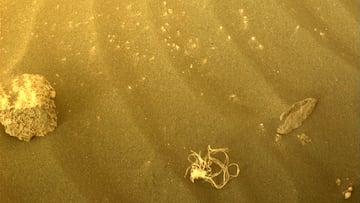What’s the strange object NASA’s Perseverance rover found on Mars?
It turns out there isn’t a ‘flying spaghetti monster’ roving the Red Planet. NASA has come up with a rather more boring explanation.

In July, social-media speculation was sparked by the appearance of a mystery, string-like object in an image taken on Mars by NASA’s Perseverance rover. Many internet users likened it to spaghetti, some even dubbing it the ‘flying spaghetti monster’.
Well, NASA now has an explanation for what the object is, and no: the space agency doesn’t think Perseverance has discovered extra-terrestrial life that takes on the form of Italian cuisine.
“Discarded debris are common” - NASA scientist Maki
In a blog post this week, Justin Maki, an imaging scientist at NASA’s Jet Propulsion Laboratory, revealed that the ‘spaghetti’ is in fact thought to be a piece of netting from thermal blankets, which were used to protect the rover from the extreme temperatures its spacecraft was subjected to when it landed on the Red Planet. “Discarded debris are common in space missions,” Maki notes.
Rover jettisoned a lot of hardware during landing
And you can certainly see why it is such a regular occurrence. On its way to the Martian surface in February 2021 - during a final descent dubbed by NASA as the ‘Seven Minutes of Terror’ - Perseverance had to shed a lot of gear destined for a crash-landing into the ground.
Stored between a backshell and a heat shield as it approached Mars, Perseverance was attached to a descent rocket. After penetrating the planet’s atmosphere, a parachute was deployed to slow the rover down from around 1,000 mph to 200 mph, and the heat shield was jettisoned. Soon after, the parachute was also discarded, before Perseverance and its descent rocket separated from the backshell.
Finally, having used its downward-facing engines to further slow the rover’s speed and deliver it to its landing site, the descent rocket flew off and crashed to the surface at a safe distance from Perseverance.
‘Spaghetti’ netting “subjected to strong forces”
In April, the parachute and backshell were photographed by Ingenuity, an autonomous mini helicopter that travelled to Mars with Perseverance. They could be seen about two-thirds of a mile from the rover’s landing location in Jezero Crater, with the backshell sitting upright but displaying noticeable damage.
“Some of the EDL [entry, descent and landing] hardware broke into smaller pieces when it impacted the surface,” Maki explains, leading to the discovery of a number of small-scale objects in the Hogwallow Flats region of Jezero Crater, just over a mile from where the rover landed. This is where Perseverance photographed the ‘spaghetti’ netting, which “appears to have undergone significant unraveling/shredding, suggesting that it was subjected to strong forces”, Maki said.
Thermal-blanket netting was also spotted in Hogwallow Flats in June, as was a bright material later determined to be multi-layer insulation from the descent stage. “Hogwallow Flats appears to be a natural collecting point for windblown EDL debris,” Maki said.
Watch: Video of Perseverance landing
NASA, ESA aim to return Perseverance samples to Earth by 2030s
Sent to Mars to collect rock and sediment samples as part of its chief task of finding signs of ancient life on the Red Planet, Perseverance has so far collected 12 samples, NASA said on Friday.
In July, the agency offered an update on its plans to retrieve the rover’s samples and bring them back to Earth, as part of a joint mission with the European Space Agency (ESA). NASA and ESA’s revised Mars Sample Return programme, which aims to return the samples to our home planet in 2033, now includes two helicopters similar in design to Ingenuity. They are to help Perseverance transport samples to a rocket - known as the Mars Ascent Vehicle - which will lift off into Mars orbit. There, an Earth Return Orbiter will be waiting to carry the payload back to Earth.






